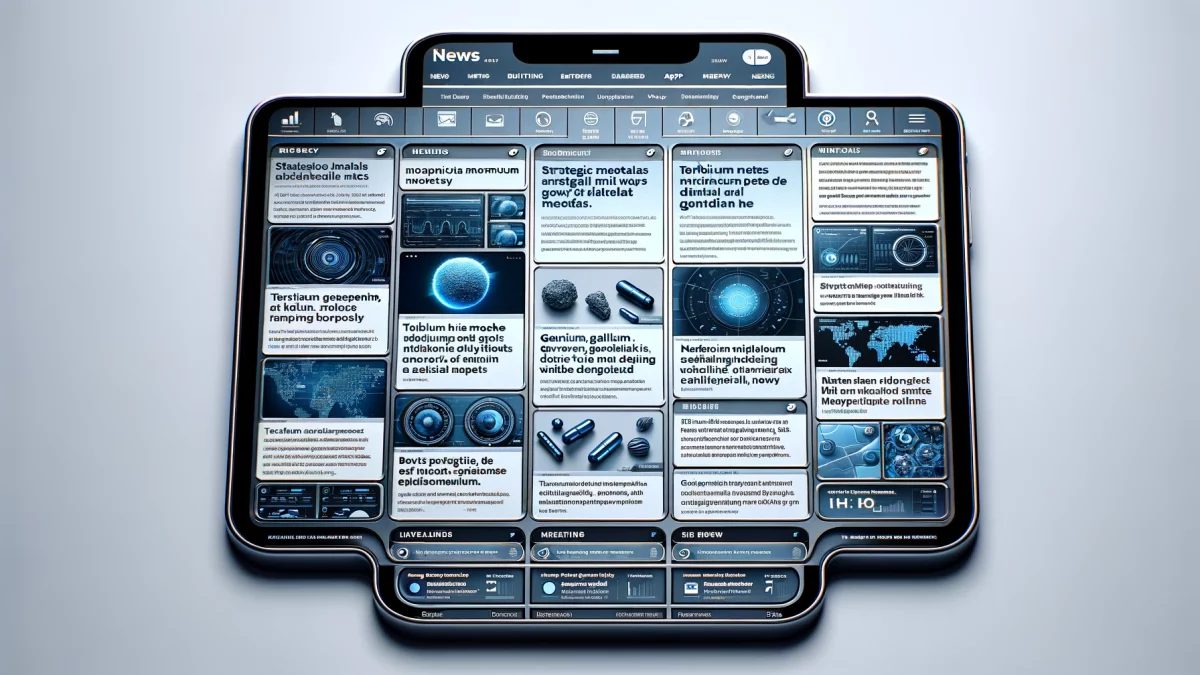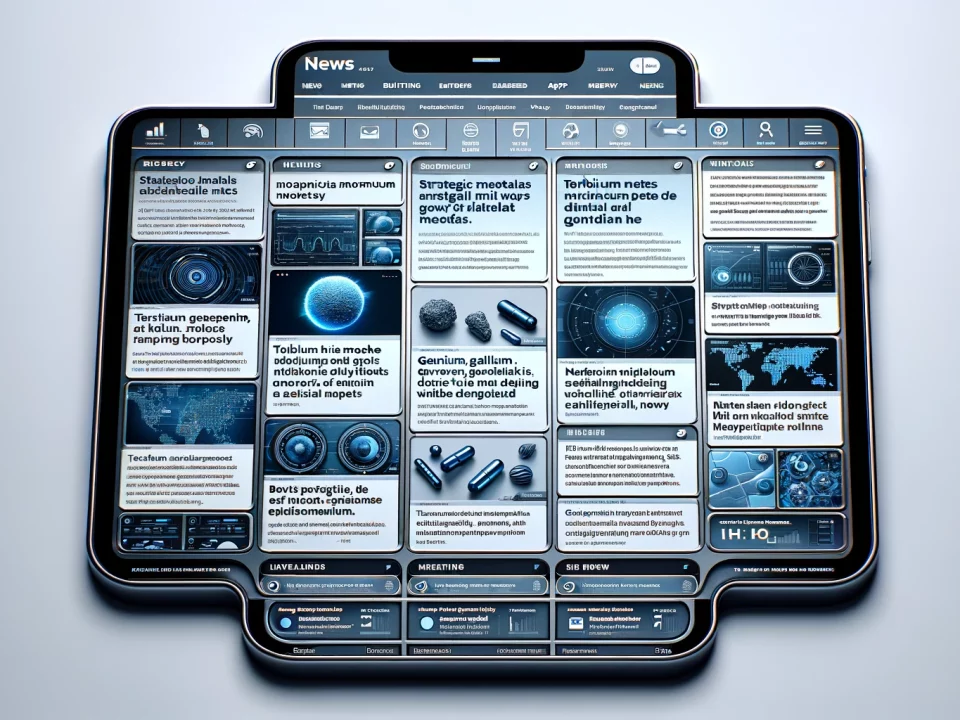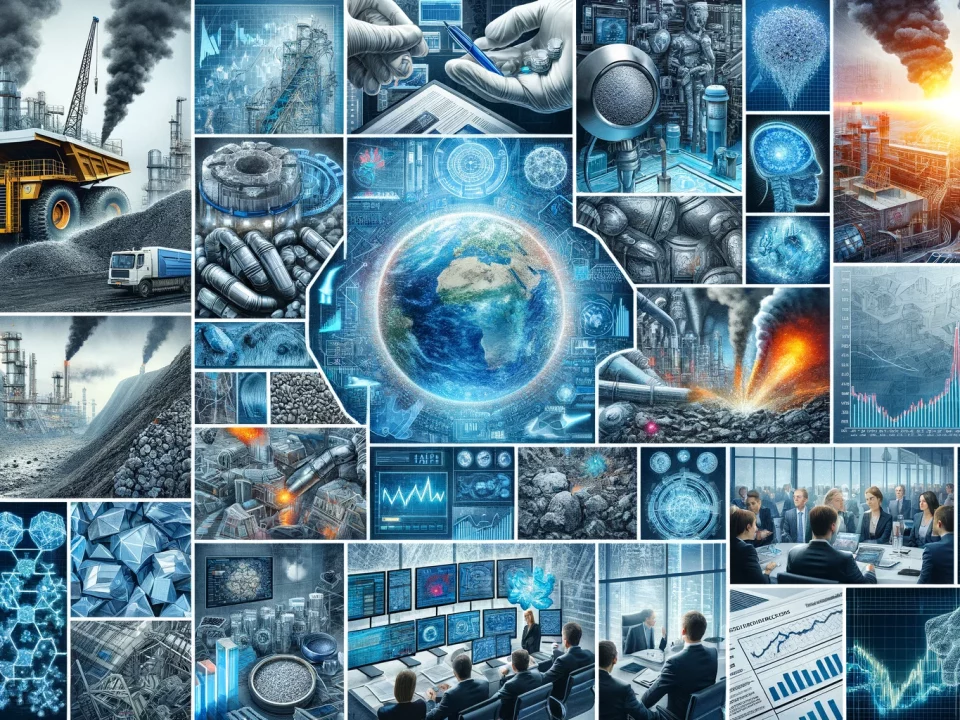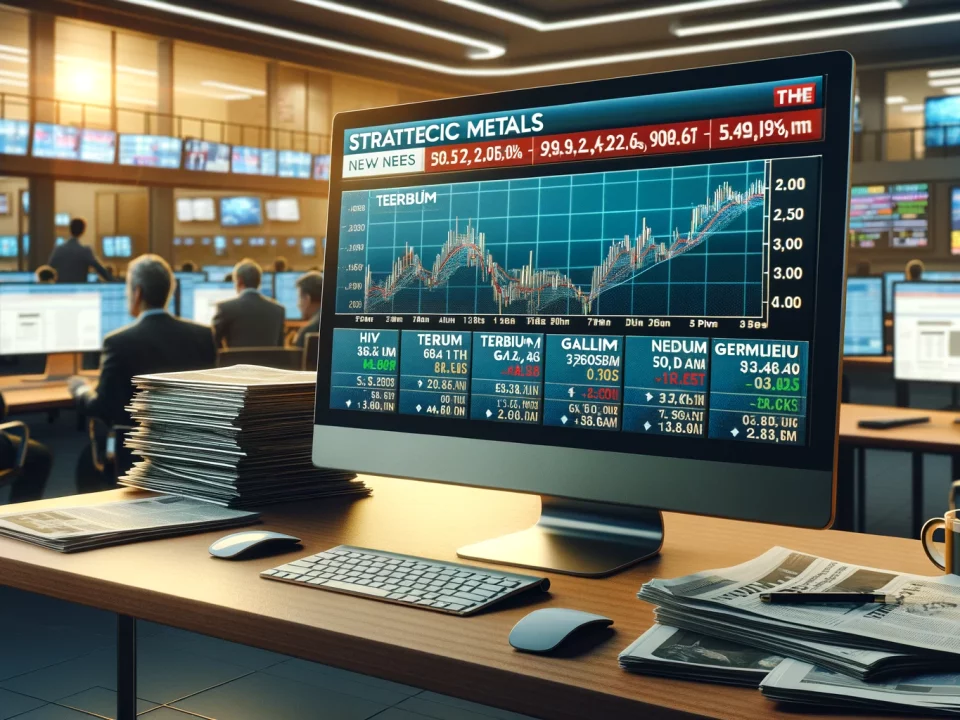
Weekly News Review September 16 – September 22 2024
September 22, 2024
Weekly News Review September 30 – October 6 2024
October 6, 2024Welcome to our weekly news review.
UNITED STATES: AGREEMENT WITH AUSTRALIA AND US TO BE FINALIZED FOR STRATEGIC METALS COOPERATION:
Prime Minister Anthony Albanese said on Friday in Philadelphia following a meeting with U.S. President Joe Biden that Australia seeks to finalize a critical minerals agreement with the United States this year.
According to Albanese, the two politicians discussed geopolitical issues ahead of the Quadrilateral Security Dialogue meeting and the Critical Minerals Compact between the two countries, which was first announced in May last year. Albanese is hopeful they can finalize the agreement “by the end of this year.” Under the so-called compact, Australia and the U.S. are set to deepen their cooperation on clean energy and critical minerals and seek to coordinate policies and investments better.
Albanese highlighted Australia’s mineral wealth, underlining the possibility of supplying allied nations with coveted resources. Australia supplies around half of the world’s lithium and has vast amounts of other critical minerals like rare earths.
So far, China has dominated the sector, accounting for most of the mining and refining of critical minerals. In light of recent geopolitical tensions, Western nations have begun to launch efforts to diversify their supply chains. For example, the European Union and the United Arab Emirates have also signed raw material agreements with Australia. Meanwhile, the U.S. Senate passed the Critical Mineral Task Force Act last week to strengthen domestic supply chains.
UNITED STATES AND INDIA JOIN FORCES ON SEMICONDUCTORS:
Biden and Modi announced a “landmark agreement” to produce infrared, gallium nitride, and silicon carbide semiconductors, including for national security purposes.
India and the U.S. have announced the joint construction of a factory for infrared, gallium nitride, and silicon carbide semiconductors on the subcontinent. The “watershed arrangement” was revealed in a joint statement by U.S. President Joe Biden and Indian Prime Minister Narendra Modi. The facility is set to produce “advanced sensing, communication, and power electronics for national security, next-generation telecommunications, and green energy applications.”
The project will be facilitated through a strategic technology partnership between Indian companies Bharat Semi and 3rdiTech and the U.S. Space Force. Further support is planned through the India Semiconductor Mission, which is part of the Indian Ministry of Electronics and Information Technology. According to the Economic Times (Paywall), the initiative is part of Modi’s vision to transform India from a consumer of semiconductor chips into a manufacturer. India imports semiconductors worth one billion U.S. dollars annually for national security alone.
According to the statement, India and the U.S. also plan to expand their existing global and strategic partnership in other technology sectors and areas such as defense and healthcare. Both nations aim to mobilize around one billion dollars for Indian clean energy supply chains through the International Bank for Reconstruction and Development (IBRD).
Biden and Modi’s discussions took place during a meeting of the Quad group, which includes Australia and Japan, alongside India and the U.S., and is seen as a counterbalance to China’s influence in the Indo-Pacific. The U.S. implemented measures two years ago to restrict China’s chip access amid increasing geopolitical tensions. In apparent response, China imposed export controls on gallium and germanium, critical raw materials for the semiconductor industry last summer.
UNITED STATES: WYOMING RARE EARTH PROJECT SECURES $456 MILLION IN GOVERNMENT FINANCING –
According to initial scoping studies, the deposit ranks among the world’s largest.
The Export-Import Bank of the United States (EXIM) has awarded American Rare Earths (ARR) $456 million in debt financing through a non-binding letter of interest to advance the Halleck Creek Project in Wyoming. In a statement on Wednesday, ARR said the funds cover the entire initial capital expenditure for the project, representing the first stage in development. Once operational, the mine is expected to produce rare earth elements, including neodymium, praseodymium, and dysprosium, all needed to make magnets used in electric vehicle motors or wind turbines.
China dominates the global production of rare earths and its downstream processing, including magnet making. The U.S. and other Western nations seek to diversify their supply chains by promoting more domestic mining of rare earths and other critical minerals. EXIM also indicated financing for an antimony mine in the U.S. earlier this year. The raw material is used to produce flame retardants and ammunition.
Resource Estimate Ranks the Project Among the World’s Largest:
According to a scoping study published in March, Halleck Creek ranks among the world’s largest rare earth deposits with an estimated 7.5 million tons of contained material, 24 percent of which are projected to be the coveted magnet rare earths. However, these figures are only estimations based on initial drilling studies, and the final reserves have yet to be determined.
While financing is one aspect of developing a mine, time is also significant. From the initial exploration, until a project can begin production, many years or even decades can pass as permits must be secured, studies conducted, and infrastructure constructed. Halleck Creek is still in the exploration stages. ARR expects the construction of process facilities alone to take three years.
TEXAS: RESEARCHERS WORKING ON SUSTAINABLE METHOD TO RECYCLE STRATEGIC METALS:
“Flash heating” aims to reduce costs and greenhouse gas emissions.
The demand for critical minerals for green and digital technologies is growing, while their availability is limited, and production is often concentrated in a few countries. Recycling is becoming increasingly important to secure supply and reduce both import dependency and the need for new mining projects.
A research team from Rice University in Texas has now developed a method to recover metals from electronic waste more efficiently and environmentally friendly. According to the university’s press release, many conventional recycling methods are energy-intensive or require acids, leaving behind dangerous waste products. The new method, however, relies on precise temperature control and rapid metal separation without using water, acids, or other solvents.
It builds on previous work by scientists James Tour and Bing Deng on waste processing using Flash Joule Heating. In this process, electrical current is passed through a material, heating it to extremely high temperatures of over 2,000 degrees Celsius within a short time, transforming it into various substances.
According to the researchers, this technique successfully separated metals like tantalum from capacitors, gallium from LEDs, and indium from solar film. By precisely controlling reaction conditions, they achieved metal purity levels of over 95% and more than 85% yields. The process could significantly reduce operating costs and greenhouse gas emissions, explains Tour.
Next, the method will be adapted to recover other critical metals from waste streams. The researchers believe it could also be suitable for extracting lithium and rare earth elements essential for energy and transportation transitions.
US LED INITIATIVE MSP (MINERALS SECURITY PARTNERSHIP) UNVEILS NEW FINANCING NETWORK –
Finance institutions will team up with private industry to strengthen supply chains of strategic metals.
On Monday, the Minerals Security Partnership (MSP) members unveiled a new financing network to coordinate joint projects better and facilitate information sharing. According to a joint statement, the MSP Financing Network will direct its members’ export credit and development finance agencies to join forces with private industry to support critical mineral mining, refining, and recycling projects to diversify and bolster supply chains.
The press release emphasizes that the MSP values projects that adhere to environmental, social, and governance (ESG) standards and promote local value creation, which has positive impacts on regional economies and communities.
Ten projects have so far secured MSP support. The list includes Australian Strategic Materials’ Dubbo rare earth project, which received a non-binding letter of interest to provide debt financing of up to $600 million, and Canadian cobalt producer Electra Battery Materials, which was awarded a $20 million investment from the U.S. Pentagon earlier this year. The MSP is currently evaluating 30 more projects.
The Minerals Security Partnership is a multilateral association comprising 14 countries and the European Union founded in 2022 following a U.S. initiative. It seeks to strengthen supply chains of critical minerals by connecting industry nations with resource-rich nations. The background of this is China’s dominance in the sector and Western nations’ dependency on the People’s Republic. In June, South Korea assumed the one-year lead of the MSP.
NEW IEA REPORT OUTLINES PATH TO REACH COP28 GOALS:
Tripling renewable energy capacity and doubling energy efficiency are feasible with the right levers pulled.
At the United Nations Climate Change Conference (COP28) in Dubai last year, over 120 countries signed the pledge to triple the installed renewable energy capacity, double the energy efficiency by 2030, and reach net zero emissions by 2050. To achieve these ambitious targets, a massive ramping up of financing, more coordination, and dedicated policy support is needed, the International Renewable Energy Agency (IRENA) argued earlier this year. The International Energy Agency (IEA) has followed suit and published a report on Tuesday outlining how this could happen and how the COP28 goals could be achieved.
The IEA argues that the tripling of renewables will succeed with sufficient energy storage and the necessary power grid to transport it. It estimates that a global storage capacity of 1.500 GW and the construction or modernization of 25 million kilometers of grids are essential to reaping the benefits of renewables expansion. In addition, the share of electricity in final energy consumption must reach 30 percent, and coal usage must decline, according to the report. As revealed in an earlier IEA report, the resource sector stands at the center stage in achieving these targets.
Different Countries Have Different Starting Points:
Yet, the IEA acknowledges that countries have different starting points on their path to their climate targets, providing them with various guidelines. While expanding the use of electric vehicles, heat pumps, and other clean energy technologies is central to reaching the COP28 targets in advanced economies, emerging markets must strengthen and enforce efficiency standards for new buildings, factories, and appliances. The IEA primarily argues that the efficiency of air conditioners must increase.
The report comes ahead of the upcoming COP29 in Baku, Azerbaijan, from November 11 through 24. According to the IEA, COP29 will be a focal point to reach global climate targets, and any backsliding could risk agreed-upon goals.
AUSTRALIA: LIQUID GALLIUM COULD MAKE AMMONIA PRODUCTION MORE SUSTAINABLE:
Researchers in Australia are developing a new catalyst for one of the world’s most-produced chemicals.
Fertilizers, plastics, medicines, food—ammonia is essential for producing numerous everyday products. It is also crucial for the energy and transportation transition, particularly as a carrier for green hydrogen. With rising demand in these sustainable sectors, analysts expect the ammonia market to triple by 2050.
However, new eco-friendly production methods are needed. The current industry standard, the Haber-Bosch process, requires high temperatures and pressures, contributing up to 2% of global CO2 emissions. A potential solution, developed under the leadership of the Royal Melbourne Institute of Technology (RMIT) in Australia, could significantly reduce this footprint.
Dr. Karma Zuraiqi, lead author of the study published in Nature Catalysis, explains that compared to the Haber-Bosch process, this new method would use 20% less heat and 98% less pressure. This is made possible by an innovative catalysis approach.
Liquid Gallium and Copper: “As effective as the gold standard”
While noble metals like ruthenium are typically used as catalysts to split nitrogen and hydrogen, the research team utilizes molten copper and gallium. These elements allow for more dynamic chemical reactions, improving efficiency, says RMIT professor Torben Daeneke. Though copper and gallium are poor catalysts on their own, together, they excel. Gallium facilitated nitrogen splitting in the experiments, while copper accelerated hydrogen splitting. The low-energy method proved as effective as the current gold standard but is more climate-friendly and cost-efficient.
Another benefit: while ammonia production via the Haber-Bosch process is only feasible in large plants, this alternative method can also be used for smaller, decentralized production, such as in solar parks, reducing transport costs and emissions.
RMIT aims to commercialize this technology and scale it for various industrial applications.
CANADA: BMW AND MICROSOFT INVEST IN RARE EARTH RECYCLING:
The Canadian company focuses on recovering rare earths from magnets in end-of-life products.
Canadian critical minerals recycling company Cyclic Materials has secured another $53 million from investors, including the venture capital branches of German carmaker BMW and Japanese conglomerate Hitachi, as well as Microsoft’s Climate Innovation Fund. According to a press statement, the start-up will use the investment to fast-track international growth and build rare earth recycling infrastructure in the United States and Europe.
Founded in 2021, Cyclic Materials focuses on recovering rare earths from permanent magnets from end-of-life products such as electric vehicle motors, wind turbines, MRI machines, and electronic waste. Companies with which Cyclic signed partnerships include German magnet maker Vacuumschmelze and Swedish energy company Vattenfall, which seeks to recycle 100 percent of its permanent magnets used in wind turbines under a new initiative. On the other hand, British vehicle salvaging company Synetiq will supply EVs and auxiliary vehicle motors from which Cyclic aims to recover magnets.
Pieces in the Puzzle of the Recycling Value Chain:
Cyclic extracts a mixture of rare earth oxides (MREO) from these magnets, which must be further separated into individual rare earths before elements such as neodymium or praseodymium can be reused. Belgian chemical company Solvay has already signed an offtake agreement with Cyclic Materials to refine the MREO at its plant in France (we reported). Solvay then aims to supply European magnet makers and automotive companies with the raw materials, essentially completing the recycling value chain. This could reduce the need for more mines and limit import dependencies.
The funding round, led by ArcTern Ventures, was the latest in a series of investments since Cyclic’s inception in 2021. Microsoft’s Innovation Fund and BMWi Ventures were already involved in the start-up earlier.
CANADA: DEFENSE METALS AND THE SRC JOINING FORCES ON RARE EARTHS:
Rare earths mined in British Columbia could soon be refined in Saskatchewan.
Canadian rare earth mining hopeful Defense Metals has signed a Memorandum of Understanding with the Saskatchewan Research Council (SRC) to explore potential collaboration along the rare earth value chain. Under the agreement, the two sides will discuss a possible supply agreement of mixed rare earth carbonates from Defense Metals’ Wicheeda project to SRC’s rare earth refinery in Saskatoon.
The facility recently began commercial production of rare earth metal, the first in North America (we reported). Rare earth metal is produced by smelting individual rare earth oxides together. It is an intermediate product in the convoluted mine-to-magnet value chain.
Guy de Selliers, executive chairman of Defense Metals, said in a statement that a potential long-term agreement between the two sides could be a significant step towards more secure and sustainable North American rare earth supply chains.
Defense Metals is developing its Wicheeda rare earth project 80 km northeast of Prince George in Canada’s westernmost province, British Columbia. The project has road and rail access to the port of Prince Rupert.
Infrastructure is a critical factor in developing new mining projects in terms of costs and time. In July, the Canadian government announced it would invest in critical minerals infrastructure to facilitate access to the coveted raw materials.
GERMANY: GALLIUM OPENS UP NEW PERSPECTIVES FOR CATALYSIS:
Discovery by German scientists could advance industrial processes.
Catalysts are substances that trigger or accelerate chemical reactions without being consumed. They are essential in everyday life—fertilizers, plastics, medicines, food, and cosmetics are just a few examples of products whose production relies on catalysts. One of the most well-known uses is in vehicle exhaust purification systems.
Traditional catalysts are usually based on rare and expensive precious metals like iridium and rhodium. Researchers worldwide are exploring alternatives using more abundant metals like aluminum or gallium, which also offer unique chemical properties.
However, catalytic concepts developed for precious metals cannot simply be applied to other elements, explains Prof. Dr. Robert Kretschmer, Chair of Inorganic Chemistry at the Technical University (TU) of Chemnitz, Germany. He has discovered a research team that could lead to new methods.
For the first time, a reaction has been observed in a gallium compound previously known only for other metals. Typically, gallium seeks to increase the number of bonds in response, but the Chemnitz team successfully created a compound in which the metal ended up with only one bond.
Kretschmer explains that such compounds are extremely rare, and only a few research groups worldwide can “tame” such molecules in the lab. In this case, the gallium atom jumped between two carbon atoms—an insertion reaction that plays a crucial role in many industrial processes. This discovery could be the foundation for developing catalytic processes using new materials like gallium.






